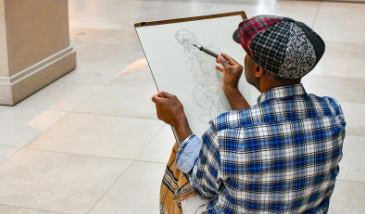So you want to be an Art Major

A starving artist is someone who sacrifices material well-being in order to focus on their passion. They typically live on minimum expenses, either for a lack of business or because all their disposable income goes toward art projects. Some starving artists crave mainstream success and popularity but have difficulty due to high barriers to entry in fields such as the visual arts, the film industry, and theatre. These artists frequently take temporary positions such as waitering or other service industry jobs while they focus their attention on “breaking through” in their preferred field.
In just six months hordes of freshly minted college graduates will be thrown out into the real world with one burning question: what now? Some, unfortunately, will be slapped with the unsettling feeling that their degree is not marketable in this tough economic environment and others will of course thrive.
The worst art majors to pursue based on unemployment, earnings, and projected growth from 2010–2020 are the Fine Arts (which was surveyed to be the least valuable major altogether by Bankrate with the average income after graduation being $40,855 and an unemployment rate of 9.1%); Drama and Theater Arts; Film, Video, and Photographic Arts; Commercial Art and Graphic Design; Architecture; English Literature and Language; Journalism; Anthropology and Archeology; and lastly, music.
But wait, there’s still hope! Here are the most rewarding occupations related to art: Art Director, Art Agent/Business Manager, Art Professor, Commercial Artist, Animator, Interior Designer, Graphic Designer, Art Gallery Dealer, Advertising Designer, and Freelance Writer.
The most important things Art Majors can do is prepare and stand out. Some ways to do that include: budgeting carefully (Being self-employed means being without pension, holiday pay or maternity benefits. Incidents such as illness, injury, or having children require pre-emptive financial planning.), self-promotion (showcase talents on social media, maybe even make a website. Having a good online presence shows employers an artist is self-motivated and digitally literate), socializing (networking events are the art world’s equivalent to job hunting but more fun), get involved (many artists form collectives to publicise and exhibit their work like an art club but for adults), portfolio (A good body of work speaks louder than grades.), get a job (Doing so gives financial security while exercising creative passions), intern (Working for a company can prepare artists with essential industry skills, improve employability, and is a great networking experience). The creative sector is characterised by high levels of job satisfaction. As a result, the industry is highly competitive and jobs are sought after. If you have the passion and the motivation to stay ahead of the game, then a creative career can be an exciting and rewarding experience.
For More Information Visit:
https://www.scholarships.com/news/
https://www.thedailybeast.com/
https://www.bestcollegesonline.org/highest-paying-jobs/arts-majors/
